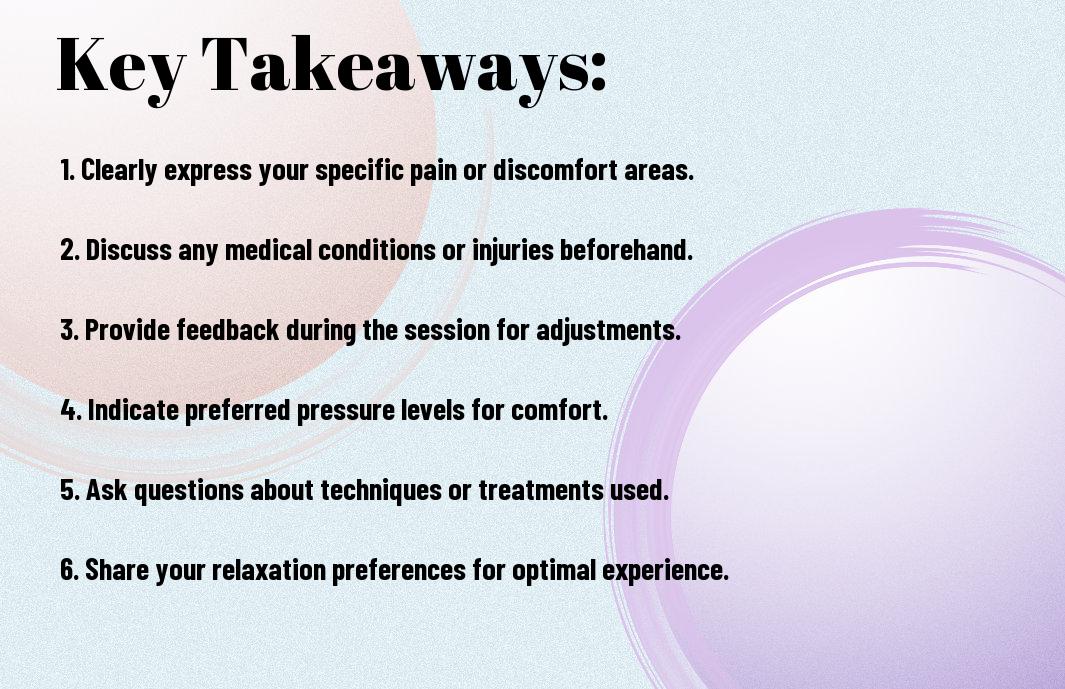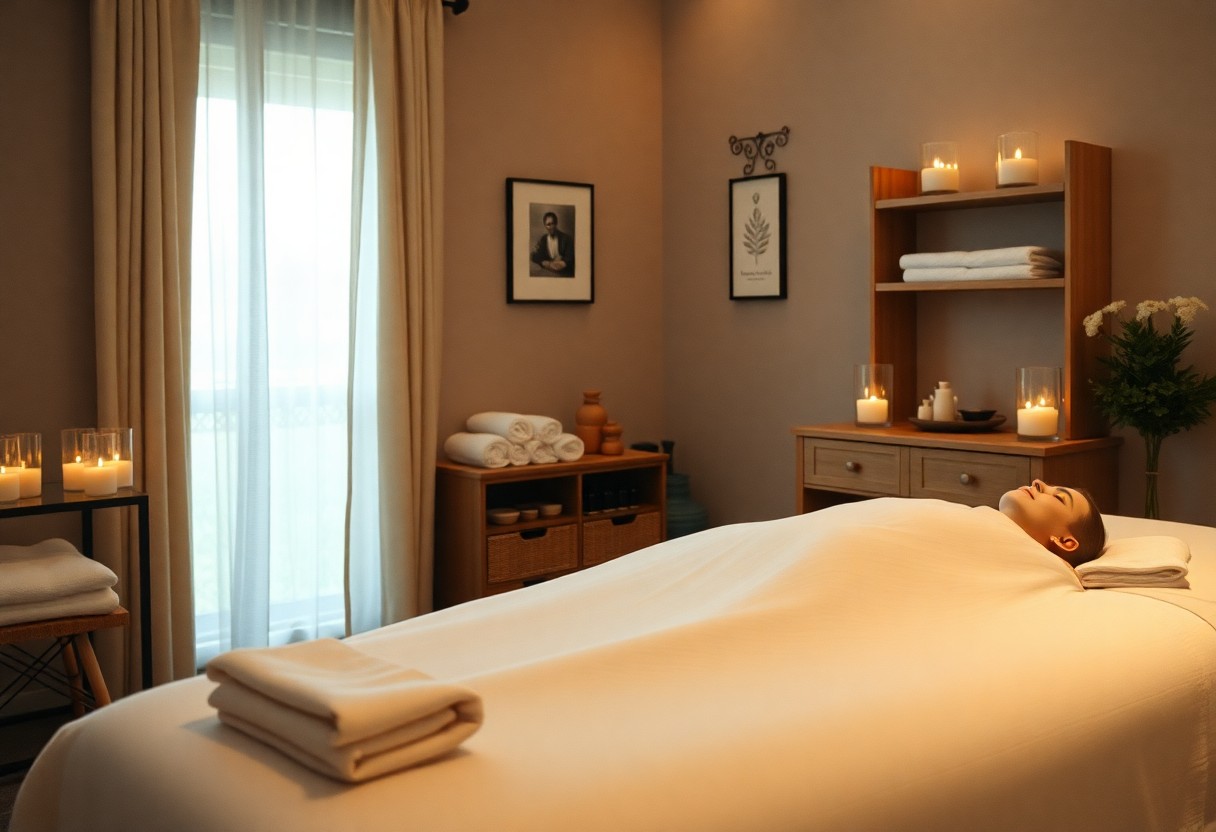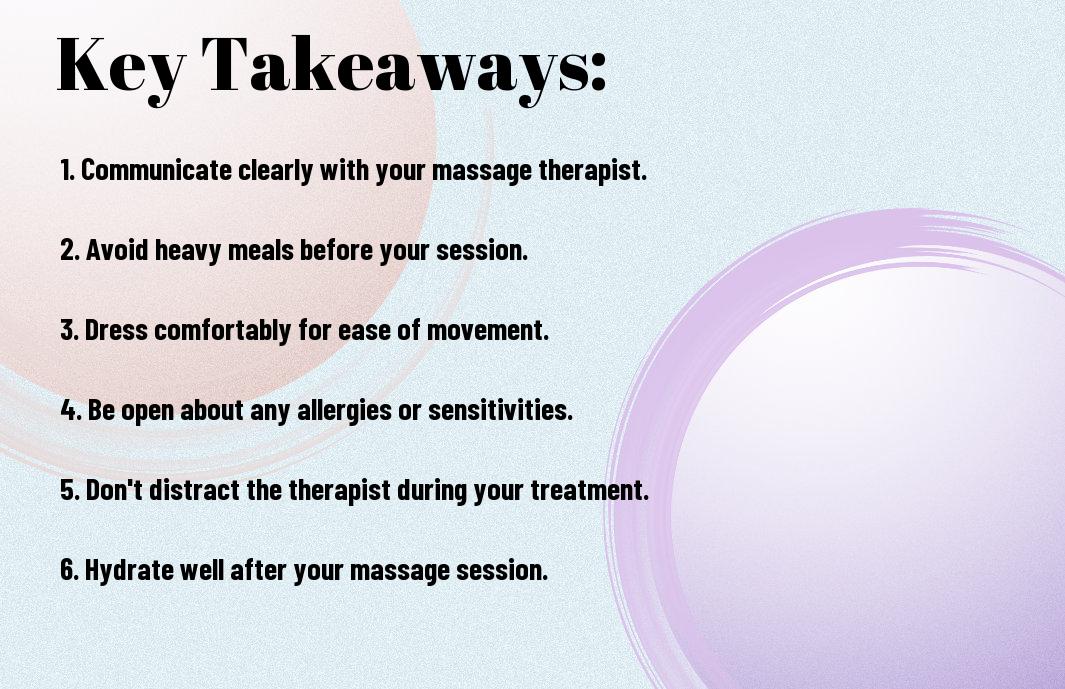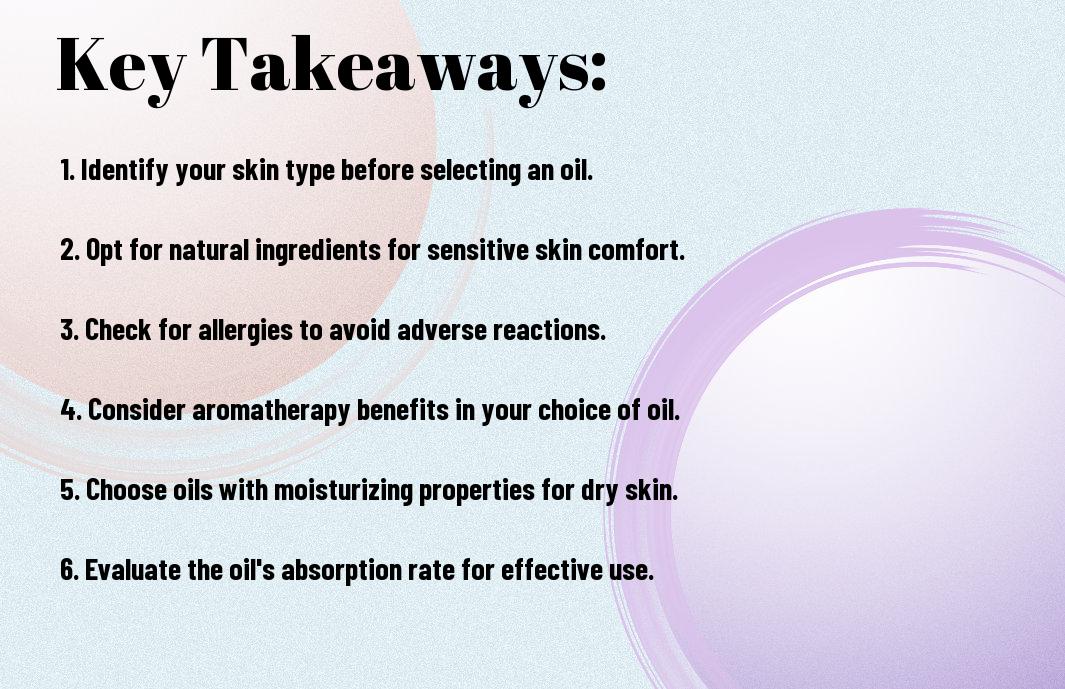Effective communication is crucial in ensuring your massage therapy experience meets your expectations and needs. By sharing your preferences and any concerns with your therapist, you can create an environment where you feel comfortable and understood. This blog post will guide you through key strategies to enhance your communication during your sessions. For further insights, check out these Tips for Optimal Communication with Your Massage Therapist.
Key Takeaways:
- Be Open and Honest: Sharing your health history, preferences, and any areas of discomfort helps your therapist tailor the session to your needs.
- Express Preferences: Communicating your desired pressure level and specific techniques ensures a more enjoyable and effective experience.
- Provide Feedback: During and after the session, offering constructive feedback can improve future treatments and enhance your overall experience.
Understanding Your Needs
Before your massage session begins, it’s important to take the time to reflect on what you hope to achieve. Evaluating your physical condition, stress levels, and particular areas of tension allows you to effectively communicate with your therapist. By articulating your needs clearly, you help create a more personalized experience that aligns with your expectations and desired outcomes.
Identifying Areas of Discomfort
The first step in enhancing your massage experience is to pinpoint areas of discomfort. Take note of specific muscle groups or persistent tension that you experience daily. Providing this information helps your therapist tailor the massage techniques to target those problem areas effectively.
Setting Treatment Goals
Before starting your session, it’s beneficial to establish clear treatment goals. Are you seeking pain relief, increased flexibility, or relaxation? Communicating these objectives to your therapist will ensure that the massage is specifically designed to meet your individual needs.
Areas that you want to focus on should correlate directly with your treatment goals. Whether you’re looking to alleviate chronic pain or to unwind, defining these goals beforehand allows your therapist to create a session plan that meets your expectations. The more specific you can be about your desired outcomes, the better equipped your therapist will be to facilitate the results you are looking for.
Establishing Rapport
The relationship you cultivate with your massage therapist is important for a beneficial experience. A strong rapport will help you feel more comfortable discussing your needs, preferences, and any areas of concern. Investing time in establishing this connection can lead to a more personalized session, ultimately enhancing the effectiveness of your massage therapy.
Importance of Trust
Along your journey to better wellness, building trust with your massage therapist is key. When you trust them, you’re more likely to share relevant information about your body and any discomfort you may have. This openness allows your therapist to tailor treatments specifically to you, ensuring a more effective and satisfying massage experience.
Open Communication Channels
Open communication is vital in maximizing your massage therapy benefits. Establishing a comfortable dialogue where you feel free to express your thoughts, concerns, and expectations will enhance the overall effectiveness of your sessions.
It’s important to communicate any discomfort or preferences before and during your massage. Feel free to discuss pressure levels, specific areas of tension, or any existing injuries. Your therapist can only help you if they have all the information they need. Consistent feedback during your sessions can also help adjust techniques and approaches, ensuring your massage aligns with your unique needs.
Providing Feedback
Despite the belief that a massage session is simply a time for relaxation, your feedback is vital for ensuring the experience meets your expectations. Openly communicating your preferences, discomfort, or specific areas of tension allows your therapist to tailor the treatment to your needs. Don’t hesitate to share your thoughts during and after the session, as this helps build a relationship that enhances each visit.
During the Session
Below are a few ways you can provide feedback during your massage. Speak up if the pressure is too light or too firm and let your therapist know if a particular technique doesn’t feel right. Your comfort and satisfaction should guide the treatment, so don’t hold back on sharing your needs.
After the Session
An imperative part of the feedback process occurs after your massage. Take the time to discuss how you felt during the treatment and any areas that stood out, whether positively or negatively. This dialogue not only helps your therapist adjust future sessions but also allows you to clarify what works best for your body.
At this point, you can also express any concerns that arose post-massage, such as soreness or relaxation levels. Sharing this feedback informs your therapist about potential adjustments needed in technique or pressure, ensuring your future experiences are even more effective and enjoyable. A collaborative approach ultimately enhances the benefits of your massage therapy journey.
Discussing Preferences
Not expressing your preferences during a massage can lead to an unsatisfactory experience. Openly communicating what you like or dislike helps your therapist tailor the session to your needs. Whether it’s your preferred type of massage or specific areas that require focus, sharing this information will ultimately enhance your relaxation and overall satisfaction.
Pressure and Technique
To ensure you receive the most beneficial massage, be clear about the pressure you prefer. Some people enjoy deep tissue work, while others may find it uncomfortable and might prefer lighter techniques. Letting your therapist know your preferences allows them to adjust their approach and technique for your comfort.
Ambiance and Environment
Beside preferences in pressure and technique, the ambiance and environment play a significant role in your massage experience. Discuss factors such as lighting, temperature, and music with your therapist to create a personalized atmosphere that helps you relax and unwind.
Consequently, taking the time to articulate your ideal ambiance can greatly enhance your comfort during the session. If you prefer dim lighting or a specific type of music, convey this to your therapist beforehand. Your input on the environment can help establish the tranquility and serenity you need, allowing you to fully benefit from the massage.
Addressing Health Concerns
For an effective massage experience, it’s important to address any health concerns you may have with your therapist. Openly sharing this information helps them tailor the treatment to your specific needs and ensures a safe session. Whether you have chronic conditions or temporary issues, being transparent allows your therapist to provide you with the best care possible.
Sharing Medical History
About your medical history, it’s imperative to provide your massage therapist with an overview of any past or present conditions. This includes issues such as hypertension, diabetes, or surgeries. By sharing this information, you enable your therapist to choose techniques that will be both effective and safe for your body.
Informing About Injuries
On the topic of injuries, informing your massage therapist about any recent or ongoing issues can significantly impact your treatment. If you have sustained injuries from sports, accidents, or other activities, letting your therapist know allows them to adjust their approach to avoid exacerbating any pain or discomfort.
To ensure a safe and effective massage, detail any injuries you have experienced, particularly those that are recent or affecting your mobility. Discussing where you feel pain, how it occurred, and any treatments you have received will help your therapist understand how to best assist you. This collaborative communication can lead to better outcomes and a more tailored massage experience that meets your needs.
Cultivating a Collaborative Relationship
Keep in mind that the bond between you and your massage therapist is built on open communication and trust. By expressing your needs, preferences, and any concerns, you create a supportive environment where your therapist can tailor the session to your individual requirements. This collaboration enhances your overall massage experience and encourages a deeper understanding of your body’s needs.
Working Together for Your Well-being
At the heart of a successful massage therapy experience is teamwork. You and your therapist can work together to identify areas of tension and discomfort, allowing for a more focused and beneficial session. Providing feedback during and after your session enables your therapist to adjust techniques and pressure, ensuring that your specific needs are met.
Setting Realistic Expectations
The journey to relief and relaxation often requires patience and understanding. It’s important to acknowledge that while massage therapy can bring significant benefits, it may not resolve all issues in a single session. Openly discussing your goals with your therapist can help align expectations and create a more satisfying experience.
Further, understanding that each person’s body responds differently to massage can help you maintain a positive outlook. Progress may vary depending on factors such as muscle tightness, stress levels, and overall health. By communicating openly with your massage therapist about what you hope to achieve, you can develop a tailored plan that addresses your needs over time, fostering gradual improvement and understanding of your body’s response.
To wrap up
Taking this into account, effective communication with your massage therapist can greatly enhance your overall experience. Be open about your preferences, discuss any areas of discomfort, and provide feedback throughout the session. This dialogue fosters a better understanding of your needs, allowing your therapist to tailor the treatment to suit you. By articulating your expectations clearly, you empower your therapist to deliver a massage that is not only relaxing but also beneficial for your well-being.
FAQ
Q: How should I communicate my pain levels to my massage therapist?
A: It’s important to be open and honest about any discomfort or pain you experience during your massage. Use a scale from 1 to 10 to describe your pain level, with 1 being minimal discomfort and 10 being unbearable. Let your therapist know if the pressure is too much or if there’s a specific area that needs more focus. This feedback helps them adjust their techniques accordingly for a more effective session.
Q: What specific requirements should I discuss with my massage therapist before the session?
A: Before your massage begins, discuss any specific goals or areas of concern. If you have any medical conditions, recent injuries, or areas you would like the therapist to avoid, be sure to communicate these as well. Sharing this information gives the therapist a better understanding of your needs and helps tailor the session to be more beneficial for you.
Q: Is it appropriate to ask for a specific technique during the massage?
A: Definitely! If you have a preference for certain techniques, such as deep tissue, Swedish, or trigger point therapy, let your therapist know. A skilled massage therapist will appreciate your input and may even suggest which techniques might be most effective based on your requirements. Open dialogue can enhance the overall experience.
Q: What should I do if I feel uncomfortable during the massage?
A: If you start to feel uncomfortable in any way, whether due to pain, awkward positioning, or temperature, don’t hesitate to speak up. You can ask the therapist to adjust the pressure, change positions, or provide a blanket if you’re feeling cold. Your comfort is key to a successful massage, and your therapist wants you to feel at ease.
Q: How do I provide feedback after the massage session?
A: Providing feedback after your session can help your therapist enhance future treatments. Share what you liked and what could be improved: Was the pressure appropriate? Did you feel relaxed? Were there areas that could benefit from more focus in future sessions? Constructive feedback is valuable for both you and the therapist as it fosters a better understanding of your preferences and needs.










